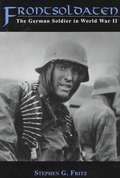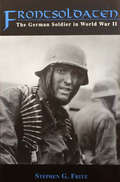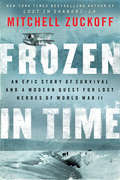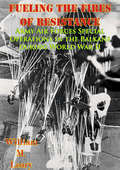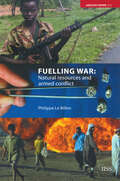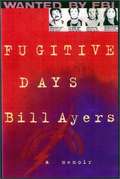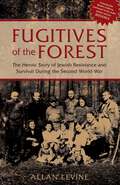- Table View
- List View
Frontline and Experimental Flying With the Fleet Air Arm
by Geoffrey HiggsThe first Royal Navy pilot to fly transatlantic non-stop (in a Buccaneer) describes his thirty-five-year career in the Fleet Air Arm and as an Empire Test Pilot. The spectacle of Alan Cobham&’s Flying Circus and the Fleet at anchor in Weymouth inspired the author&’s lifelong passion for aeroplanes, flying and the Royal Navy. World War Two provided the opportunity to fulfil his ambition and at eighteen he volunteered for the Fleet Air Arm as a pilot. Training in Canada began a Naval flying career that spanned thirty-years. Front line squadron service, embarked on aircraft carriers was followed by qualification as a flying instructor. Selection for the Empire Test Pilots School at Farnborough and qualification as an experimental Test Pilot changed the direction of his naval career. In all he flew nearly one hundred types of aircraft and carried out close to a thousand deck landings. Initial flight testing of several new naval aircraft, as well as research flying in support of the development of aircraft such as the English Electric Lightning and Concorde added to a unique career. Such a long and varied period of flying was not without the inevitable mishaps. A near catastrophic catapult launch of a new naval aircraft, the jamming of the power control system in a research aircraft and hazardous flying through tropical storms at supersonic speeds to determine safety factors for Concorde&’s intended Far East route were some of the dangers of flying at the cutting edge. As pilot, he flew the first Royal Naval aircraft to cross the Atlantic non-stop without in-flight refuelling or navigational aids. He describes the fascinating ten-day flight from Croydon to Rangoon across Europe, the Middle East, Pakistan and India to deliver a Percival Provost trainer to the Burmese Air Force.Praise for Frontline and Experimental Flying with the Fleet Air Arm &“Follow Higgs from one cockpit/conference room/country to another. You&’ll be as surprised as he is that he lived to tell about some of these adventures.&” —Speedreaders &“This hefty [book] chronicles . . . a life crammed with flying all types of aircraft, mostly shipboard, and the inevitable mishaps. . . . A good read, particularly for those of us who soak up anything to do with ships and aircraft. The shipboard accounts of catapult trials, amongst other sections, are gripping, and the times in Singapore and the Far East add to the appeal, as do the various accounts of life alongside the Americans. Geoffrey Higgs flew nearly 100 different types of aircraft in his career and his love of flying shines through the pages.&” —Alan Rawlinson
Frontline: The sweeping WWI drama that 'deserves to be read' - Jeffrey Archer
by Hilary Jones'The doctor hits the spot and deserves to be read' - Jeffrey Archer 'A story to get the heart racing' - Daily Express 'An enthralling tale' - Daily Mirror 'Dr Hilary is a master storyteller' - Lorraine Kelly CBE ___________LOVE GAVE THEM STRENGTH. LOVING EACH OTHER GAVE THEM COURAGE. Britain and her allies are engaged in a long war with Germany.Grace is the daughter of landed gentry, volunteering as a nurse on the Western Front.Will is the son of a dockworker, driven to enlist by a sense of patriotism and the thrill of adventure.When their lives collide in a field hospital in France, they form a passionate connection.This is a sweeping and sumptuous WW1 drama and historical epic, perfect for fans of Ken Follett, Kate Mosse and Jeffrey Archer.
Frontline: The sweeping WWI drama that 'deserves to be read' - Jeffrey Archer
by Hilary Jones'The doctor hits the spot and deserves to be read' - Jeffrey Archer 'A story to get the heart racing' - Daily Express 'An enthralling tale' - Daily Mirror 'Dr Hilary is a master storyteller' - Lorraine Kelly CBE ___________LOVE GAVE THEM STRENGTH. LOVING EACH OTHER GAVE THEM COURAGE. Britain and her allies are engaged in a long war with Germany.Grace is the daughter of landed gentry, volunteering as a nurse on the Western Front.Will is the son of a dockworker, driven to enlist by a sense of patriotism and the thrill of adventure.When their lives collide in a field hospital in France, they form a passionate connection.This is a sweeping and sumptuous WW1 drama and historical epic, perfect for fans of Ken Follett, Kate Mosse and Jeffrey Archer.
Frontsoldaten: The German Soldier in World War II
by Stephen G. FritzIn exploring the reality of the Landser, the average German soldier in World War II, through letters, diaries, memoirs, and oral histories, Stephen G. Fritz provides the definitive account of the everyday war of the German front soldier. The personal documents of these soldiers, most from the Russian front, where the majority of German infantrymen saw service, paint a richly textured portrait of the Landser that illustrates the complexity and paradox of his daily life.
Frontsoldaten: The German Soldier in World War II
by Stephen G. Fritz&“Drawn from letters, diaries and memoirs, this impressive study presents a rounded, detailed picture of the daily life&” for frontline Nazi soldiers (Publishers Weekly). Stephen G. Fritz explores the day-to-day reality of the average German infantryman—or Landser—during World War II. Through letters, diaries, memoirs, and oral histories, most of which describe life on the Russian front, Fritz presents a richly textured portrait of the Landser that illustrates the complexity and paradox of his daily life. Although clinging to a self-image as a decent fellow, the German soldier nonetheless committed terrible crimes in the name of The Third Reich. When the war was finally over, and his country lay in ruins, the Landser faced a bitter truth: all his exertions and sacrifices had been in the name of a deplorable regime that had committed unprecedented crimes. With chapters on training, images of combat, living conditions, combat stress, the personal sensations of war, the bonds of comradeship, and ideology and motivation, Fritz reveals war through the eyes of these self-styled &“little men.&”
Frost Fire (The Fire Trilogy)
by Linda LaddThe Fire Trilogy ignites with one woman&’s quest for Civil War vengeance—&“packed with subplots and supporting characters that keep the action percolating&” (Publishers Weekly). Join Linda Ladd in this first book of an exciting trilogy as she takes you on an incredible journey from the terrors of war to the comforts of love. She is intent on avenging her dishonor by the man who had taken more from her than she could ever possibly imagine. She has nothing, and so there is nothing she can lose, but she is intent on using any means necessary to take back what is rightfully hers. Born out of the ravages of war, theirs is a love that cannot be denied, blurring the boundaries forged by conflict until both are on the edge of a dizzying abyss where only passion matters, and surrender is sweet.
Frozen Chosin: U.S. Marines At The Changjin Reservoir [Illustrated Edition] (Marines In The Korean War Commemorative Series #7)
by Brigadier General Edwin H. SimmonsIncludes more than 40 maps, plans and illustrations.This volume in the official History of the Marine Corps chronicles the part played by United States Marines in the Chosin Reservoir Campaign.The race to the Yalu was on. General of the Army Douglas MacArthur's strategic triumph at Inchon and the subsequent breakout of the U.S. Eighth Army from the Pusan Perimeter and the recapture of Seoul had changed the direction of the war. Only the finishing touches needed to be done to complete the destruction of the North Korean People's Army. Moving up the east coast was the independent X Corps, commanded by Major General Edward M. Almond, USA. The 1st Marine Division, under Major General Oliver P. Smith, was part of X Corps and had been so since the 15 September 1950 landing at Inchon.After Seoul the 1st Marine Division had reloaded into its amphibious ships and had swung around the Korean peninsula to land at Wonsan on the east coast. The landing on 26 October 1950 met no opposition; the port had been taken from the land side by the resurgent South Korean army. The date was General Smith's 57th birthday, but he let it pass unnoticed. Two days later he ordered Colonel Homer L. Litzenberg, Jr., 47, to move his 7th Marine Regimental Combat Team north from Wonsan to Hamhung. Smith was then to prepare for an advance to the Manchurian border, 135 miles distant. And so began one of the Marine Corps' greatest battles--or, as the Corps would call it, the "Chosin Reservoir Campaign." The Marines called it the "Chosin" Reservoir because that is what their Japanese-based maps called it. The South Koreans, nationalistic sensibilities disturbed, preferred--and, indeed, would come to insist--that it be called the "Changjin" Reservoir.
Frozen in Time
by Mitchell ZuckoffThe author of the best-selling Lost in Shangri-La recounts the November 1942 crash of a U. S. cargo plane into the Greenland Ice Cap, the loss of the B-17 sent to find it, and the loss of a Grumman Duck amphibious plane that had managed to rescue one B-17 crew member. The remaining crew endured 148 days of Arctic winter before finally being rescued. With a 200,000-copy first printing.
Fu-go: The Curious History of Japan's Balloon Bomb Attack on America (Studies in War, Society, and the Military)
by Ross CoenNear the end of World War II, in an attempt to attack the United States mainland, Japan launched its fu-go campaign, deploying thousands of high-altitude hydrogen balloons armed with incendiary and high-explosive bombs designed to follow the westerly winds of the upper atmosphere and drift to the west coast of North America. After reaching the mainland, these fu-go, the Japanese hoped, would terrorize American citizens and ignite devastating forest fires across the western states, ultimately causing the United States to divert wartime resources to deal with the domestic crisis. While the fu-go offensive proved to be a complete tactical failure, six Americans lost their lives when a discovered balloon exploded. Ross Coen provides a fascinating look into the obscure history of the fu-go campaign, from the Japanese schoolgirls who manufactured the balloons by hand to the generals in the U.S. War Department who developed defense procedures. The book delves into panic, propaganda, and media censorship in wartime. Fu-go is a compelling story of a little-known episode in our national history that unfolded virtually unseen.
Fuel for Fire (Black Knights Inc. #10)
by Julie Ann WalkerA USA Today Bestseller!A brooding covert operative and a spunky CIA agent discover a burning passion in the next installment of Julie Ann Walker's red-hot BKI seriesDagan Zoelner has made three huge mistakes The first two left blood on his hands. The third left him wondering…what if? What if he had told the woman of his dreams how he felt before his world fell apart?Spitfire CIA agent Chelsea Duvall has always had a thing for bossy, brooding Dagan. It's just as well that he's never given her a second look, since she carries a combustible secret about his past that threatens to torch their lives..."The heat between the hero and heroine is hotter than a firecracker lit on both ends... Readers are in for one hell of ride!" —RT Book Reviews for Hell for Leather 4½ Stars
Fuel on the Fire
by Greg MuttittThe departure of the last U.S. troops from Iraq at the end of 2011 left a broken country and a host of unanswered questions. What was the war really about? Why and how did the occupation drag on for nearly nine years, while most Iraqis, Britons, and Americans desperately wanted it to end? And why did the troops have to leave?Now, in a gripping account of the war that dominated U.S. foreign policy over the last decade, investigative journalist Greg Muttitt takes us behind the scenes to answer some of these questions and reveals the heretofore-untold story of the oil politics that played out through the occupation of Iraq. Drawing upon hundreds of unreleased government documents and extensive interviews with senior American, British, and Iraqi officials, Muttitt exposes the plans and preparations that were in place to shape policies in favor of American and British energy interests. We follow him through a labyrinth of clandestine meetings, reneged promises, and abuses of power; we also see how Iraqis struggled for their own say in their future, in spite of their dysfunctional government and rising levels of violence. Through their stories, we begin to see a very different Iraq from the one our politicians have told us about.In light of the Arab revolutions, the war in Libya, and renewed threats against Iran, Fuel on the Fire provides a vital guide to the lessons from Iraq and of the global consequences of America's persistent oil addiction.
Fueling the Fires of Resistance — Army Air Forces Special Operations in the Balkans during World War II [Illustrated Edition] (The U.S. Army Air Forces in World War II #2)
by William M. LearyIncludes 14 illustrationsOf all the Army Air Forces' many operations in the Second World War, none was more demanding or important than those supporting the activity of resistance groups fighting the Axis powers. The special operations supporting the Yugoslavian partisans fighting the forces of Nazism in the Balkans required particular dedication and expertise. Balkan flying conditions demanded the best of flying skills, and the tenacious German defenses in that troubled region complicated this challenge even further. In this study, Professor William Leary examines what might fairly be considered one of the most important early experiences in the history of Air Force special operations. It is ironic that, fifty years after these activities, the Air Force today is heavily involved in Balkan operations, including night air drops of supplies. But this time, the supplies are for humanitarian relief, not war. The airlifters committed to relieving misery in that part of the world follow in the wake of their predecessors who, fifty years ago, flew the night skies with courage and skill to help bring an end to Nazi tyranny.
Fuelling War: Natural Resources and Armed Conflicts (Adelphi series #373)
by Philippe Le BillonA generous endowment of natural resources should favour rapid economic and social development. The experience of countries like Angola and Iraq, however, suggests that resource wealth often proves a curse rather than a blessing. Billions of dollars from resource exploitation benefit repressive regimes and rebel groups, at a massive cost for local populations. This Adelphi Paper analyses the economic and political vulnerability of resource-dependent countries; assesses how resources influence the likelihood and course of conflicts; and discusses current initiatives to improve resource governance in the interest of peace. It concludes that long-term stability in resource-exporting regions will depend on their developmental outcomes, and calls for a broad reform agenda prioritising the basic needs and security of local populations.
Fuentes de Oñoro 1811
by Rene Chartrand Patrice CourcelleThis Osprey title examines the crucial campaign culminating in the hard-fought battle that finally drove the French from Portugal during the Napoleonic Wars (1799-1815). In October 1810 the Allied position in Portugal appeared precarious. Despite defeating Marshal Masséna's French army at Bussaco, Wellington had been forced to retreat to within a few miles of Lisbon. Here the French encountered a massive line of fortifications stretching from the River Tagus to the sea. Built amid great secrecy and on Wellington's specific orders, these Lines of Torres Vedras were the French high-water mark. In February, with his army on the point of starvation, Masséna was forced to retreat and the scene was set for the climactic action of Fuentes de Oñoro.
Fugitive (Jack Lark)
by Paul Fraser CollardIn this ninth action-packed Victorian military adventure, Paul Fraser Collard's roguish hero Jack Lark - soldier, leader, imposter - crosses borders once more as he pursues a brand-new adventure in Africa. After five years away, Jack Lark - soldier, leader, imposter - is once more called to fight . . .London, 1868. Jack has traded the battlefield for business, running a thriving club in the backstreets of Whitechapel. But this underworld has rules and when Jack refuses to comply, he finds himself up against the East End's most formidable criminal - with devastating consequences.A wanted man, Jack turns to his friend Macgregor, an ex-officer, treasure hunter and his ticket out of England. Together they join the British army on campaign across the tablelands of Abyssinia to the fortress of Magdala, a high-stakes mission to free British prisoners captured by the notorious Emperor Tewodros.But life on the run can turn dangerous, especially in a land ravaged by war . . . Praise for the Jack Lark series:'Brilliant' Bernard Cornwell'Enthralling' The Times 'Dusty deserts, showdowns under the blistering sun, bloodthirsty bandoleros, rough whisky and rougher men. Bullets fly, emotions run high and treachery abounds in The Lost Outlaw... an exceptionally entertaining historical action adventure' Matthew Harffy'I love a writer who wears his history lightly enough for the story he's telling to blaze across the pages like this. Jack Lark is an unforgettable new hero' Anthony Riches'You feel and experience all the emotions and the blood, sweat and tears that Jack does... I devoured it in one sitting' Parmenion Books'Expect ferocious, bloody action from the first page. Fast-paced, compelling, and with more villains than a Clint Eastwood classic, this unputdownable novel strongly reminded me of that legend of western writers, Louis L'Amour. A cracking read!' Ben Kane(P)2020 Headline Publishing Group Ltd
Fugitive (Jack Lark, Book 9)
by Paul Fraser Collard'Once again, Paul Fraser Collard proves he is a true master of action adventure' MATTHEW HARFFY'Like all the best vintages Jack Lark has aged to perfection. Scarred, battered and bloody, his story continues to enthral' ANTHONY RICHESRoguish hero Jack Lark - soldier, leader, imposter - crosses borders once more as he pursues a brand-new adventure in Africa. For fans of Bernard Cornwell's Sharpe series, Matthew Harffy and Patrick O'Brian.CAN THE BATTLEFIELD SAVE A WANTED MAN?London, 1868. Jack Lark is now a businessman, running a thriving club in the Whitechapel backstreets. But when he goes up against the East End's most notorious criminal, the consequences are devastating.A wanted man, Jack joins the British army on campaign across Abyssinia, a high-stakes mission that returns him to the battlefield and on to the fortress of Magdala where the formidable Emperor Tewodros has taken British subjects prisoner.But life on the run can turn dangerous, especially in a land ravaged by war . . .Praise for the Jack Lark series:'Brilliant' Bernard Cornwell'Enthralling' The Times'Bullets fly, emotions run high and treachery abounds' Matthew Harffy'Expect ferocious, bloody action from the first page' Ben Kane'You feel and experience all the emotions and the blood, sweat and tears that Jack does... I devoured it in one sitting' Parmenion Books
Fugitive (Jack Lark, Book 9)
by Paul Fraser Collard'Once again, Paul Fraser Collard proves he is a true master of action adventure' MATTHEW HARFFY'Like all the best vintages Jack Lark has aged to perfection. Scarred, battered and bloody, his story continues to enthral' ANTHONY RICHESRoguish hero Jack Lark - soldier, leader, imposter - crosses borders once more as he pursues a brand-new adventure in Africa. For fans of Bernard Cornwell's Sharpe series, Matthew Harffy and Patrick O'Brian.CAN THE BATTLEFIELD SAVE A WANTED MAN?London, 1868. Jack Lark is now a businessman, running a thriving club in the Whitechapel backstreets. But when he goes up against the East End's most notorious criminal, the consequences are devastating.A wanted man, Jack joins the British army on campaign across Abyssinia, a high-stakes mission that returns him to the battlefield and on to the fortress of Magdala where the formidable Emperor Tewodros has taken British subjects prisoner.But life on the run can turn dangerous, especially in a land ravaged by war . . .Praise for the Jack Lark series:'Brilliant' Bernard Cornwell'Enthralling'The Times'Bullets fly, emotions run high and treachery abounds' Matthew Harffy'Expect ferocious, bloody action from the first page' Ben Kane'You feel and experience all the emotions and the blood, sweat and tears that Jack does... I devoured it in one sitting'Parmenion Books
Fugitive 13: The explosive thriller that will have you gripped (Sleeper 13 #2)
by Rob SinclairThe explosive, gripping new thriller from bestselling author Rob Sinclair - for fans of Orphan X, I Am Pilgrim and Nomad.Aydin Torkal - aka Sleeper 13 - is on the run.Hunted not only by the world's intelligence agencies, but also by the elite brotherhood of insurgents he betrayed, he has lived the past year like a ghost.Until now.MI6 agent Rachel Cox knows Aydin better than anyone. The only person who believes he is an ally in the ongoing war on terror, not the enemy. So when a coded message arrives from him, warning her not to trust her own colleagues, Rachel must choose between her career and the truth.But as Aydin hunts down those who destroyed his childhood, the trail he follows will lead him closer to home than he ever expected.He won't stop until he has his revenge.He is FUGITIVE 13.READERS ARE BEING GRIPPED BY THE SLEEPER 13 THRILLER SERIES:'Perfect for spy thriller lovers and fans of I Am Pilgrim, Orphan X' - Goodreads review'I could not put down this book' - Netgalley reviewer'Brilliant, gripping' - Netgalley reviewer
Fugitive 13: The second action-packed, thrilling instalment of the best-selling, gripping series (Sleeper 13 #2)
by Rob SinclairThe explosive second book in the SLEEPER 13 thriller series, by Rob Sinclair - for fans of Orphan X, I Am Pilgrim and Nomad.Aydin Torkal - aka Sleeper 13 - is on the run.Hunted not only by the world's intelligence agencies, but also by the elite brotherhood of insurgents he betrayed, he has lived the past year like a ghost.Until now.MI6 agent Rachel Cox knows Aydin better than anyone. The only person who believes he is an ally in the ongoing war on terror, not the enemy. So when a coded message arrives from him, warning her not to trust her own colleagues, Rachel must choose between her career and the truth.But as Aydin hunts down those who destroyed his childhood, the trail he follows will lead him closer to home than he ever expected.He won't stop until he has his revenge.He is FUGITIVE 13.
Fugitive Days: A Memoir
by Bill AyersAyers helped found the Weather Underground in the late 1960s in response to the horror of the Vietnam War. He recounts a decade of living as a fugitive, stealing explosives, hiding from the law, and losing his beloved Diana Oughton in an explosion. The 2001 edition was published by Beacon Press. Annotation ©2004 Book News, Inc. , Portland, OR (booknews. com)
Fugitive Son: A Memoir
by Aramís CalderónAramís Calderón was eleven in 1992 when federal marshals conducted a nighttime raid at the Baton Rouge apartment where he lived with his mother and four siblings. They were searching for Aramís&’s father, who had escaped from a nearby federal prison. Once satisfied with the answers from Aramís&’s mother, the marshals departed. At daybreak, so did Aramís&’s family—and drove toward a rendezvous with his father, who had fled to South Florida. Thus began an eight-month ordeal of constant moves, family aliases, and drug deals. As Calderón shares, Fugitive Son is not a love letter to his father, whom he sees even after his death as an unethical, toxic, and incredibly complex man. Rather, Calderón&’s memoir explores how his father&’s undeniable love for his family despite drug addiction, lawlessness, and toxic masculinity informed Aramís&’s rebellious decision to join the Marines, and how all this shaped his determination to become the father he wished his own had been.
Fugitive of the Stars
by Edmond HamiltonHorne, the spaceship's pilot, had been warned. "Don't forget the meteor swarm." And Horne's directional calculations for the Vega Queen's course took that advice into account; the spaceship would go fifteen thousand miles out of its way to avoid those deadly celestial rocks. But when Horne went off duty, he felt himself numbed by a curious druglike leadenness. And the next thing he knew, he was in a lifeboat, speeding away from the floating wreckage of the Vega Queen. Eighteen survivors out of one hundred and fifty-three passengers. And each one in the tiny space shell believed Horne responsible...deliberate negligence, calculated destruction...Someone had drugged Horne, he knew; someone had tampered with the ship to alter its course. But who? And for what cosmic purpose?
Fugitives of the Forest: The Heroic Story Of Jewish Resistance And Survival During The Second World War
by Allan LevineThe heroic story of Jewish resistance and survival during the Second World War.
Fuimos soldados (Edición 2021): Historia secreta de la contraofensiva montonera
by Marcelo LarraquyDespués de las exitosas obras Galimberti y López Rega, Marcelo Larraquy reconstruye las historias de ese puñado de hombres y mujeres a los que se reconoce como desaparecidos pero no como soldados, y a quienes la manipulación política dejó afuera del canon de la memoria setentista. Lazarte, un combatiente rebelde, expulsado de la guerrilla montonera, quiere matar a los miembros de la Conducción, a quienes responsabiliza por la desaparición de su hermana durante la dictadura militar. Para cumplir con su plan, necesita ser reincorporado y recuperar la confianza de los dirigentes. Se ofrece entonces para realizar una acción heroica, a la que difícilmente pueda sobrevivir: volver a la Argentina para interferir las emisiones televisivas de los partidos del Mundial '78 y propagar el discurso del comandante montonero Mario Firmenich. Contra todos los pronósticos, Lazarte alcanza su objetivo. De regreso en México, Montoneros lo readmite en sus filas y lo pone al frente de un pelotón de soldados con el que viaja nuevamente al país a cumplir otra misión peligrosa. El pelotón cruza la frontera con identidades fraguadas e intenta sobrevivir en la clandestinidad. Le faltan armas y dinero; algunos soldados desertan, otros desaparecen, pero el grupo tiene objetivos para cumplir, y Lazarte no olvida el suyo. Como ellos, otros combatientes montoneros tomaron las armas y regresaron al país entre 1978 y 1980 para combatir a la dictadura militar, mientras la sociedad festejaba en las calles los triunfos futbolísticos de esos años. Casi ninguno sobrevivió.
Fuji Fire: Sifting Ashes of a Forgotten U.S. Marine Corps Tragedy
by Chas HenryOn October 19, 1979, the largest, most intense tropical cyclone ever recorded propelled 5,500 gallons of gasoline into corrugated steel huts filled with U.S. Marines. The gas ignited, injuring seventy-three people, thirteen of them fatally. The Marine Corps commandant, a veteran of combat in World War II, Korea, and Vietnam, was stunned as he met scores of horribly burned survivors. &“Having witnessed a lot of bad things, ugly things,&” the general declared, &“none can compare to that experience.&” And yet this 1979 catastrophe on the slopes of Japan&’s iconic Mount Fuji remains all but forgotten except by those directly affected. Now, the fruits of Chas Henry&’s exhaustive four-year, two-continent investigation provide insight into what many have called the U.S. Marine Corps&’ worst-ever peacetime disaster. Fuji Fire shares the compelling and intimate stories of heartbreak and inspiration forged by these events while bringing to light new, critical analyses of the incident&’s causes and effects.


